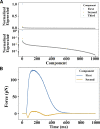Machine learning meets Monte Carlo methods for models of muscle's molecular machinery to classify mutations
- PMID: 37000171
- PMCID: PMC10067704
- DOI: 10.1085/jgp.202213291
Machine learning meets Monte Carlo methods for models of muscle's molecular machinery to classify mutations
Abstract
The timing and magnitude of force generation by a muscle depend on complex interactions in a compliant, contractile filament lattice. Perturbations in these interactions can result in cardiac muscle diseases. In this study, we address the fundamental challenge of connecting the temporal features of cardiac twitches to underlying rate constants and their perturbations associated with genetic cardiomyopathies. Current state-of-the-art metrics for characterizing the mechanical consequence of cardiac muscle disease do not utilize information embedded in the complete time course of twitch force. We pair dimension reduction techniques and machine learning methods to classify underlying perturbations that shape the timing of twitch force. To do this, we created a large twitch dataset using a spatially explicit Monte Carlo model of muscle contraction. Uniquely, we modified the rate constants of this model in line with mouse models of cardiac muscle disease and varied mutation penetrance. Ultimately, the results of this study show that machine learning models combined with biologically informed dimension reduction techniques can yield excellent classification accuracy of underlying muscle perturbations.
© 2023 Asencio et al.
Conflict of interest statement
Disclosures: The authors declare no competing interests exist.
Figures






Comment in
-
How can AI accelerate advances in physiology?J Gen Physiol. 2023 Jun 5;155(6):e202313388. doi: 10.1085/jgp.202313388. Epub 2023 Apr 27. J Gen Physiol. 2023. PMID: 37102985 Free PMC article.
Similar articles
-
[MAFbx expression after free muscle transplantation and its relationship with muscle function].Zhongguo Xiu Fu Chong Jian Wai Ke Za Zhi. 2009 Aug;23(8):969-73. Zhongguo Xiu Fu Chong Jian Wai Ke Za Zhi. 2009. PMID: 19728616 Chinese.
-
Compliant realignment of binding sites in muscle: transient behavior and mechanical tuning.Biophys J. 1998 Apr;74(4):1611-21. doi: 10.1016/s0006-3495(98)77875-0. Biophys J. 1998. PMID: 9545027 Free PMC article.
-
Sensitivity of model predictions of muscle function to changes in moment arms and muscle-tendon properties: a Monte-Carlo analysis.J Biomech. 2012 May 11;45(8):1463-71. doi: 10.1016/j.jbiomech.2012.02.023. Epub 2012 Apr 14. J Biomech. 2012. PMID: 22507351
-
Inotropic effects on mammalian skeletal muscle change with contraction frequency.Can J Physiol Pharmacol. 2003 Aug;81(8):753-8. doi: 10.1139/y03-031. Can J Physiol Pharmacol. 2003. PMID: 12897803 Review.
-
The biophysics and biochemistry of smooth muscle contraction.Can J Physiol Pharmacol. 1992 Apr;70(4):515-31. doi: 10.1139/y92-067. Can J Physiol Pharmacol. 1992. PMID: 1498719 Review.
Cited by
-
Bayesian Estimation of Muscle Mechanisms and Therapeutic Targets Using Variational Autoencoders.bioRxiv [Preprint]. 2024 Nov 13:2024.05.08.593035. doi: 10.1101/2024.05.08.593035. bioRxiv. 2024. Update in: Biophys J. 2025 Jan 7;124(1):179-191. doi: 10.1016/j.bpj.2024.11.3310. PMID: 38766103 Free PMC article. Updated. Preprint.
-
Bayesian estimation of muscle mechanisms and therapeutic targets using variational autoencoders.Biophys J. 2025 Jan 7;124(1):179-191. doi: 10.1016/j.bpj.2024.11.3310. Epub 2024 Nov 26. Biophys J. 2025. PMID: 39604261 Free PMC article.
-
How can AI accelerate advances in physiology?J Gen Physiol. 2023 Jun 5;155(6):e202313388. doi: 10.1085/jgp.202313388. Epub 2023 Apr 27. J Gen Physiol. 2023. PMID: 37102985 Free PMC article.
References
-
- Anderson, R.L., Trivedi D.V., Sarkar S.S., Henze M., Ma W., Gong H., Rogers C.S., Gorham J.M., Wong F.L., Morck M.M., et al. . 2018. Deciphering the super relaxed state of human β-cardiac myosin and the mode of action of mavacamten from myosin molecules to muscle fibers. Proc. Natl. Acad. Sci. USA. 115:E8143–E8152. 10.1073/pnas.1809540115 - DOI - PMC - PubMed
-
- Asencio, A., Powers J.D., Williams C.D.. and Daniel T.. 2019. Multifil (tropomyosin). Github. https://github.com/ama54/multifil/tree/tropomyosin
Publication types
MeSH terms
Grants and funding
LinkOut - more resources
Full Text Sources

